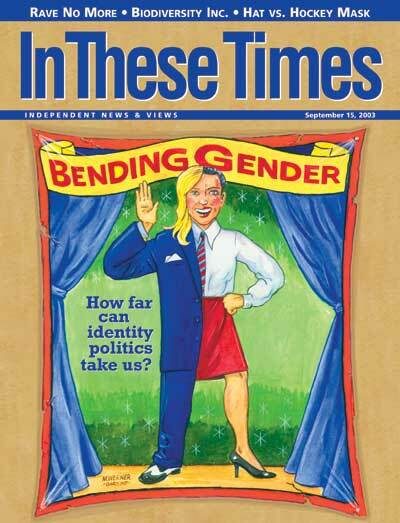
In the early part of the 21st century, American women find themselves at a powerful, transitional place in the history of gender and sexual identity.
The third wave of feminism is already here, as the brave offspring of the women’s liberation struggle of the ’60s and ’70s. In each permutation, feminism has more broadly represented American women’s concerns, with the third wave speaking out most strongly about the inextricable intersections of racism, classism, homophobia, and sexism.
It’s no exaggeration to say that we’ve come a long way. The first wave was centered completely around the educational, employment, property, and voting rights of Euro-American middle-class women in the 19th and early 20th centuries. While Sojourner Truth’s outrage at the exclusivity of the suffrage movement, her famous “Ain’t I a Woman?” speech from 1851, still resonates for many women of color, the movement continues to evolve, a dynamic collective effort toward the complete political, social, and economic equality of all women in society.
As feminism reshapes itself to meet the needs of the women who lay claim to it, increasing numbers of girls and women find themselves exploring their own boundaries—whether by intent, accident, or circumstance.
These are the women “on the edge,” pushing and pulling at the inner and outermost definitions of femininity, feminism, and womanhood. In doing so, they are rebelling not just against the dominant culture, but against a feminist culture that can be just as proscriptive in defining what is “normal.”
Women exploring their external edges include those who pursue tattooing and body modification, those who embrace sexually “deviant” practices, and those who altogether reject mainstream concepts of beauty, behavior, and desirable body size. Women grappling with their internal edges, on the other hand, include those women who are coping creatively with mental illnesses ranging from depression to bipolar disorders.
————–
Rivka Solomon is the editor of That Takes Ovaries! Bold Females and Their Brazen Acts. Published in 2002, Solomon’s book has generated more than 70 open mics, dramatizations, and readings, around the country. Held by local women, these performances are often fundraisers for local girls’ groups and organizations working to end abuses against women.
“Once again, we’re surging up to demand change,” says Solomon. “But this time [much of] the change is happening on a personal level.”
And the personal, to revisit the second wave feminist phrase, is still political. Like many who tell their bold stories in Solomon’s That Takes Ovaries, these are young women who refuse to allow anything (or anyone) to dictate to them how they should look, act, or think. They are not dropping out from society or tuning out the concept of feminism, but instead continuing to engage with their communities on their own terms.
————–
In recent years, several books have helped to posit new possibilities for what constitutes a “normal” woman’s appearance, sexual expression, body size, and even her sanity.
Those works have included Paula Kamen’s Her Way: Young Women Remake the Sexual Revolution, in which the author delves deeply into women’s sexual agency and diverging and evolving concepts of sexual satisfaction, and Caroline Knapp’s Appetites: Why Women Want, which explores tensions between feminism and anorexia. Margot Mifflin’s Bodies of Subversion: A Secret History of Women and Tattoo and Ophira Edut’s Body Outlaws: Young Women Write About Body Image and Identity both posit women’s bodies as instruments of rebellion and resistance, whether through skin and body modification, color or hair texture, or the proportions of noses, butts, and bodies.
In the realm of mental illness, it was Phyllis Chesler’s Women and Madness in 1972 that broke fresh ground by introducing a new lens through which to view women and insanity. Chesler’s work introduced the idea that the psychology of women—from varied class and ethnic backgrounds—had been strongly shaped by patriarchal culture and consciousness. Mental illness, as Chesler argued convincingly (albeit to the outrage of many of her professional peers), could be seen as a manifestation of resistance.
Since Women and Madness, books like Kay Redfield Jamison’s An Unquiet Mind, Susanna Kaysen’s Girl, Interrupted, Lizzie Simon’s Detour, and Caroline Kettlewell’s Skin Game have illuminated the inner realities of women dealing with bipolar disorders, depression, and self-mutilation. Although nearly all of these works have revolved around middle- to upper-class Euro-American women, they have nonetheless helped to remove some of the stigma and explain the survival instincts actively underlie self-destructive acts like the cutting of one’s own skin.
But since the publication of Chesler’s pivotal work, few works authored by psychiatric professionals (with the notable exception of Bruce Levine’s Commonsense Rebellion) have framed mental illness in the context of resistance and power.
————–
For women like the Seattle-based 34-year-old Maya Hurston*, rebellion is what it’s all about.
Chemical imbalances and biological predisposition to mental illness are real, but so is the power of suggestion, Hurston says. Tell a girl or a woman that she’s crazy or mentally ill enough times, she adds, and she’ll eventually start to let the concept define who she is.
Sexually molested from birth by multiple abusers, Hurston began to hear voices as a child. As she explains it, her mind became like “Swiss cheese,” with lots of holes into which she could compartmentalize her many life experiences. When she was eventually diagnosed with Multiple Personality Disorder, Hurston’s family finally had something to hold onto: She was “crazy.”
Hurston ended up a teen mom and drug dealer in a near-decade-long abusive relationship. Like her mother had once done (albeit with different intentions), her husband also told her she was crazy, all the while beating Hurston black and blue.
It took years of therapy—and, in particular, one female therapist telling her that the disassociation had been a way of surviving extreme circumstances—for things to click into place.
“I got strong, and I got tired of being a victim,” says Hurston, who now works as a university fellow, racial justice activist, wife, and mother. On the side, Hurston is also a marijuana dealer. Most of her buyers are other professional women. That’s the “edge” that she wants in her life, and she’ll be damned if anyone calls her crazy for it. It’s Hurston’s way of staying real, and thumbing her nose at the war on drugs.
For 26-year-old freelance writer Beth Grier*, living with her bipolar disorder has also meant defying the odds to make a successful career for herself. For Grier, a very low therapeutic dose of Lithium has prevented her from severe manic episodes (two previous ones landed her in the hospital), but not from wiping out her creativity. “I think there’s a reason why so many artists and thinkers throughout history were bipolar,” says Grier from her home in Charlotte, North Carolina. “There’s a certain intensity and vividness to living with it. Although being bipolar has caused me a lot of hardship, I wouldn’t choose not to be bipolar.”
Still, edgy women face challenges and obstacles at every turn. Grier, who prefers to dress in funky vintage clothing and allies herself politically with progressive and feminist movements, feels the “pressure to conform” on a daily basis for fear of being stigmatized as “completely crazy.”
————–
No such fears resonate for Renee Klorman, a 28-year-old Brooklyn resident with a master’s degree in women’s history—and an open fondness for bondage and sexual submission.
Klorman attended an all-women’s college and worked for the radical lesbian feminist publication Off Our Backs as well as for SEICUS, the Sexuality Information and Education Council of the United States. “My entire resume is feminist,” she says.
A series of loving, supportive relationships with women confirmed Klorman’s lesbianism, but she initially pushed down her interest in bondage/domination/sadomachism (BDSM) because of widespread disapproval in lesbian and feminist circles.
“I finally realized that being submissive in this one aspect of my life is a total turn-on for me. In my role as a submissive, I define exactly what I’m interested in and articulate that. The privilege that I now have of feeling comfortable engaging in BDSM and not feeling ashamed about it is an amazing thing,” says Klorman, who manages the woman-owned sex toy store Toys in Babeland in New York City. “I give major ‘props’ to the feminists and advocates of gay rights who have fought for every ounce of change we’ve gotten.”
Klorman’s particular edge isn’t just enjoying BDSM; it’s that she wants to be “dominated” by one specific man. “I only date women, sleep with women,” she says. “But I consider it subversive that I’m queer, and I do this with a guy.”
BDSM practitioners play—emotionally and physically—with boundaries of gender, power, and dominance. These are, perhaps not so coincidentally, the kinds of concepts that feminists have been analyzing and dissecting for decades. But within the more mainstream feminist movement, BDSM, and particularly sexual submission, is often thought of as a regrettable byproduct of internalized sexism—even as a manifestation of self-hatred.
Why should gay men have a culture that supports access to these kinds of sex play, asks Klorman, while lesbians and feminists are more likely to frown on such expression than to support the pursuit of a woman’s sexual satisfaction in whatever form it might arrive?
She finds immense power in submission and the level of trust necessary to make a “scene” safe and mutually pleasurable. The experience is as empowering as it is for her precisely because she has the ability to bend, exaggerate, or trespass existing gender/sex role boundaries.
The intersections of feminism and BDSM are not isolated to these kinds of personal epiphanies. In Seattle, for instance, The Stranger’s popular dominatrix-feminist columnist, “Mistress Matisse,” is organizing an all-female BDSM convention for the fall entitled “Wicked Womyn,” and last year’s woman-authored film, Secretary, brought an intelligent treatment of the complex dynamics of female sexual submission to the screen.
————–
The “edginess” of women has simultaneously generated strong interest in big-budget Hollywood. Just take a look at the plethora of female-empowered television shows in recent years—Xena, Buffy, Dark Angel, and Alias—and blockbuster movies like Charlie’s Angels and Tomb Raider.
“[T]hese women are all ass-kicking,” says author Paula Kamen. “But there are limits to this ‘movement,’ often taking place within a narrow set of boundaries.”
Those limits have almost everything to do with appearance and calculated omission of socially progressive themes. To put it another way, small waists, light skin, silky hair, cleavage, and breathy one-liners dripping with sexuality are an easy sell. When today’s studios can produce women doing aerial kick flips and utilize scripts and screenplays that skirt to any real political implications, they have no problems packaging femme fatales or busty superheroes.
Kamen says that while mainstream acceptance of edgy women may be slow in coming, she still sees young women making a difference with an “audacious sense of entitlement.”
Consider the advent of the new publication Fierce Magazine, whose targeted readers are “women who are too bold for boundaries.”
“Fierce is for all the tattooed and pierced rebels who are unafraid to throw the rules back in the world’s face, just as we’re for the quiet agitators who fit right in and urge for change with the softness of your voice,” reads the magazine’s Web site. “Fierce is feminist, it’s womanist, and it’s beyond these words. Fierce stands for all women everywhere defining themselves, coming up with new language that moves beyond politics, beyond color, beyond class.”
And in this sense, women exploring their internal and external edges constitute a social force to be reckoned with—a nascent cultural and political phenomenon of women who refuse to dull down, suppress, or even medicate themselves into normalcy.
“What’s the link between the woman who boldly fights for social justice and one who boldly has fun?” asks Solomon. “Both are acting powerfully, because each is rejecting preconceived notions of how females should behave. Each [woman] is irreverently saying, ‘No way I’m accepting limits placed on me.’”
————–
* Names have been changed to protect privacy.
The third wave of feminism is already here, as the brave offspring of the women’s liberation struggle of the ’60s and ’70s. In each permutation, feminism has more broadly represented American women’s concerns, with the third wave speaking out most strongly about the inextricable intersections of racism, classism, homophobia, and sexism.
It’s no exaggeration to say that we’ve come a long way. The first wave was centered completely around the educational, employment, property, and voting rights of Euro-American middle-class women in the 19th and early 20th centuries. While Sojourner Truth’s outrage at the exclusivity of the suffrage movement, her famous “Ain’t I a Woman?” speech from 1851, still resonates for many women of color, the movement continues to evolve, a dynamic collective effort toward the complete political, social, and economic equality of all women in society.
As feminism reshapes itself to meet the needs of the women who lay claim to it, increasing numbers of girls and women find themselves exploring their own boundaries—whether by intent, accident, or circumstance.
These are the women “on the edge,” pushing and pulling at the inner and outermost definitions of femininity, feminism, and womanhood. In doing so, they are rebelling not just against the dominant culture, but against a feminist culture that can be just as proscriptive in defining what is “normal.”
Women exploring their external edges include those who pursue tattooing and body modification, those who embrace sexually “deviant” practices, and those who altogether reject mainstream concepts of beauty, behavior, and desirable body size. Women grappling with their internal edges, on the other hand, include those women who are coping creatively with mental illnesses ranging from depression to bipolar disorders.
————–
Rivka Solomon is the editor of That Takes Ovaries! Bold Females and Their Brazen Acts. Published in 2002, Solomon’s book has generated more than 70 open mics, dramatizations, and readings, around the country. Held by local women, these performances are often fundraisers for local girls’ groups and organizations working to end abuses against women.
“Once again, we’re surging up to demand change,” says Solomon. “But this time [much of] the change is happening on a personal level.”
And the personal, to revisit the second wave feminist phrase, is still political. Like many who tell their bold stories in Solomon’s That Takes Ovaries, these are young women who refuse to allow anything (or anyone) to dictate to them how they should look, act, or think. They are not dropping out from society or tuning out the concept of feminism, but instead continuing to engage with their communities on their own terms.
————–
In recent years, several books have helped to posit new possibilities for what constitutes a “normal” woman’s appearance, sexual expression, body size, and even her sanity.
Those works have included Paula Kamen’s Her Way: Young Women Remake the Sexual Revolution, in which the author delves deeply into women’s sexual agency and diverging and evolving concepts of sexual satisfaction, and Caroline Knapp’s Appetites: Why Women Want, which explores tensions between feminism and anorexia. Margot Mifflin’s Bodies of Subversion: A Secret History of Women and Tattoo and Ophira Edut’s Body Outlaws: Young Women Write About Body Image and Identity both posit women’s bodies as instruments of rebellion and resistance, whether through skin and body modification, color or hair texture, or the proportions of noses, butts, and bodies.
In the realm of mental illness, it was Phyllis Chesler’s Women and Madness in 1972 that broke fresh ground by introducing a new lens through which to view women and insanity. Chesler’s work introduced the idea that the psychology of women—from varied class and ethnic backgrounds—had been strongly shaped by patriarchal culture and consciousness. Mental illness, as Chesler argued convincingly (albeit to the outrage of many of her professional peers), could be seen as a manifestation of resistance.
Since Women and Madness, books like Kay Redfield Jamison’s An Unquiet Mind, Susanna Kaysen’s Girl, Interrupted, Lizzie Simon’s Detour, and Caroline Kettlewell’s Skin Game have illuminated the inner realities of women dealing with bipolar disorders, depression, and self-mutilation. Although nearly all of these works have revolved around middle- to upper-class Euro-American women, they have nonetheless helped to remove some of the stigma and explain the survival instincts actively underlie self-destructive acts like the cutting of one’s own skin.
But since the publication of Chesler’s pivotal work, few works authored by psychiatric professionals (with the notable exception of Bruce Levine’s Commonsense Rebellion) have framed mental illness in the context of resistance and power.
————–
For women like the Seattle-based 34-year-old Maya Hurston*, rebellion is what it’s all about.
Chemical imbalances and biological predisposition to mental illness are real, but so is the power of suggestion, Hurston says. Tell a girl or a woman that she’s crazy or mentally ill enough times, she adds, and she’ll eventually start to let the concept define who she is.
Sexually molested from birth by multiple abusers, Hurston began to hear voices as a child. As she explains it, her mind became like “Swiss cheese,” with lots of holes into which she could compartmentalize her many life experiences. When she was eventually diagnosed with Multiple Personality Disorder, Hurston’s family finally had something to hold onto: She was “crazy.”
Hurston ended up a teen mom and drug dealer in a near-decade-long abusive relationship. Like her mother had once done (albeit with different intentions), her husband also told her she was crazy, all the while beating Hurston black and blue.
It took years of therapy—and, in particular, one female therapist telling her that the disassociation had been a way of surviving extreme circumstances—for things to click into place.
“I got strong, and I got tired of being a victim,” says Hurston, who now works as a university fellow, racial justice activist, wife, and mother. On the side, Hurston is also a marijuana dealer. Most of her buyers are other professional women. That’s the “edge” that she wants in her life, and she’ll be damned if anyone calls her crazy for it. It’s Hurston’s way of staying real, and thumbing her nose at the war on drugs.
For 26-year-old freelance writer Beth Grier*, living with her bipolar disorder has also meant defying the odds to make a successful career for herself. For Grier, a very low therapeutic dose of Lithium has prevented her from severe manic episodes (two previous ones landed her in the hospital), but not from wiping out her creativity. “I think there’s a reason why so many artists and thinkers throughout history were bipolar,” says Grier from her home in Charlotte, North Carolina. “There’s a certain intensity and vividness to living with it. Although being bipolar has caused me a lot of hardship, I wouldn’t choose not to be bipolar.”
Still, edgy women face challenges and obstacles at every turn. Grier, who prefers to dress in funky vintage clothing and allies herself politically with progressive and feminist movements, feels the “pressure to conform” on a daily basis for fear of being stigmatized as “completely crazy.”
————–
No such fears resonate for Renee Klorman, a 28-year-old Brooklyn resident with a master’s degree in women’s history—and an open fondness for bondage and sexual submission.
Klorman attended an all-women’s college and worked for the radical lesbian feminist publication Off Our Backs as well as for SEICUS, the Sexuality Information and Education Council of the United States. “My entire resume is feminist,” she says.
A series of loving, supportive relationships with women confirmed Klorman’s lesbianism, but she initially pushed down her interest in bondage/domination/sadomachism (BDSM) because of widespread disapproval in lesbian and feminist circles.
“I finally realized that being submissive in this one aspect of my life is a total turn-on for me. In my role as a submissive, I define exactly what I’m interested in and articulate that. The privilege that I now have of feeling comfortable engaging in BDSM and not feeling ashamed about it is an amazing thing,” says Klorman, who manages the woman-owned sex toy store Toys in Babeland in New York City. “I give major ‘props’ to the feminists and advocates of gay rights who have fought for every ounce of change we’ve gotten.”
Klorman’s particular edge isn’t just enjoying BDSM; it’s that she wants to be “dominated” by one specific man. “I only date women, sleep with women,” she says. “But I consider it subversive that I’m queer, and I do this with a guy.”
BDSM practitioners play—emotionally and physically—with boundaries of gender, power, and dominance. These are, perhaps not so coincidentally, the kinds of concepts that feminists have been analyzing and dissecting for decades. But within the more mainstream feminist movement, BDSM, and particularly sexual submission, is often thought of as a regrettable byproduct of internalized sexism—even as a manifestation of self-hatred.
Why should gay men have a culture that supports access to these kinds of sex play, asks Klorman, while lesbians and feminists are more likely to frown on such expression than to support the pursuit of a woman’s sexual satisfaction in whatever form it might arrive?
She finds immense power in submission and the level of trust necessary to make a “scene” safe and mutually pleasurable. The experience is as empowering as it is for her precisely because she has the ability to bend, exaggerate, or trespass existing gender/sex role boundaries.
The intersections of feminism and BDSM are not isolated to these kinds of personal epiphanies. In Seattle, for instance, The Stranger’s popular dominatrix-feminist columnist, “Mistress Matisse,” is organizing an all-female BDSM convention for the fall entitled “Wicked Womyn,” and last year’s woman-authored film, Secretary, brought an intelligent treatment of the complex dynamics of female sexual submission to the screen.
————–
The “edginess” of women has simultaneously generated strong interest in big-budget Hollywood. Just take a look at the plethora of female-empowered television shows in recent years—Xena, Buffy, Dark Angel, and Alias—and blockbuster movies like Charlie’s Angels and Tomb Raider.
“[T]hese women are all ass-kicking,” says author Paula Kamen. “But there are limits to this ‘movement,’ often taking place within a narrow set of boundaries.”
Those limits have almost everything to do with appearance and calculated omission of socially progressive themes. To put it another way, small waists, light skin, silky hair, cleavage, and breathy one-liners dripping with sexuality are an easy sell. When today’s studios can produce women doing aerial kick flips and utilize scripts and screenplays that skirt to any real political implications, they have no problems packaging femme fatales or busty superheroes.
Kamen says that while mainstream acceptance of edgy women may be slow in coming, she still sees young women making a difference with an “audacious sense of entitlement.”
Consider the advent of the new publication Fierce Magazine, whose targeted readers are “women who are too bold for boundaries.”
“Fierce is for all the tattooed and pierced rebels who are unafraid to throw the rules back in the world’s face, just as we’re for the quiet agitators who fit right in and urge for change with the softness of your voice,” reads the magazine’s Web site. “Fierce is feminist, it’s womanist, and it’s beyond these words. Fierce stands for all women everywhere defining themselves, coming up with new language that moves beyond politics, beyond color, beyond class.”
And in this sense, women exploring their internal and external edges constitute a social force to be reckoned with—a nascent cultural and political phenomenon of women who refuse to dull down, suppress, or even medicate themselves into normalcy.
“What’s the link between the woman who boldly fights for social justice and one who boldly has fun?” asks Solomon. “Both are acting powerfully, because each is rejecting preconceived notions of how females should behave. Each [woman] is irreverently saying, ‘No way I’m accepting limits placed on me.’”
————–
* Names have been changed to protect privacy.
Silja J.A. Talvi, a senior editor at In These Times, is an investigative journalist and essayist with credits in many dozens of newspapers and magazines nationwide, including The Nation, Salon, Santa Fe Reporter, Utne, and the Christian Science Monitor.








